The Story Behind the Photograph
Photographing Bats in Costa Rica
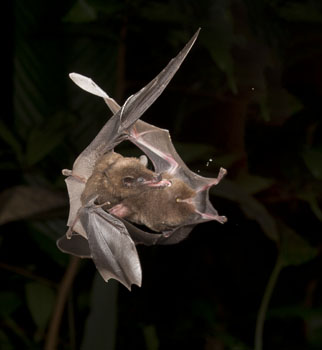
Two Orange Nectar-feeding Bats collide, made with a Range IR.
Recently we returned from our second Photo Tour in Costa Rica, where, quite unexpectedly, I had another opportunity to photograph bats. We were staying in a lodge in northern Costa Rica, photographing toucans, aracaris, and other birds, as well as coatimundis, insects, and snakes. There was a hummingbird feeding station set up in the forest where, I was told, few hummers visited. It was a disappointment, our lodge host said, before adding, but bats are drinking up all of the nectar each night!
Fortunately the feeding station wasn't too deep in the forest, just a hundred yards or so down a very muddy, slippery jungle trail. On our first evening I hiked out after dark to investigate, watching carefully as I walked, not only to not slip and fall but also to avoid stepping upon a Fer-de-Lance, a wickedly venomous snake that roams the jungles at night. Although I'd love to see one of these snakes in the wild, I'd like to do so under my terms.
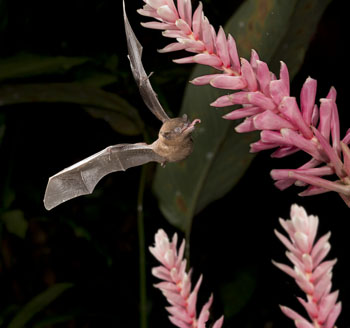
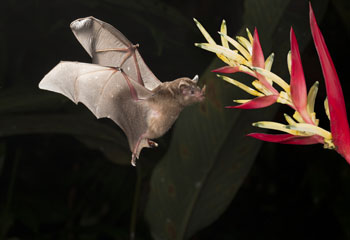
When I arrived at the feeders bats were swooping about everywhere, appearing as quick splashes of light in my headlamp. I sat down on a bench to watch and, within minutes and amongst the mosquitos, I realized a great shooting situation was at hand. The next afternoon I returned.
As best I could off-site I had previsualized how I wanted to set up the flashes and Range IR camera trigger, but when I hiked back in with the gear I found I still wasn't prepared. I needed more gear, and hiked back to the lodge for the extra accessories. When I set up, I found that our wonderful air security system, TSA, had been through my bags and had turned on one flash, draining the batteries, and removed and then reinserted the batteries the wrong way, frying another flash! So, another trip back to the lodge for replacements.
Although the set-up, afterwards, was reasonably straight forward, it still took nearly three hours to rig up several Manfrotto Lightstands, three Manfrotto Articulating Arms with Super Clamps, and the Range IR and four Flashes. I set up the Range IR at a position 180 degrees opposite what I'd done with the Tanzanian bats just a little over a month earlier, now placing the Range IR so that the beam pointed upwards towards one of the hummingbird feeders.
The beauty of the Range IR is the rheostat-like dial that allowed me to 'put out' a beam far enough to reach the hummingbird feeder but no further, so that the jungle canopy and vegetation overhead didn't trip the trigger. The Range IR's beam can be adjusted to trigger from about 3 feet to around 30, and for this series I had the beam set for about five feet.
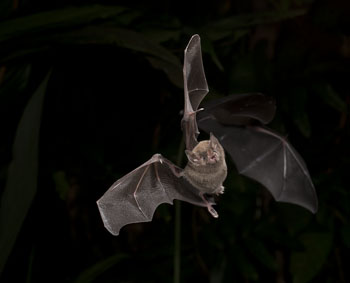 For focusing, I had to prefocus on the spot where I expected the bat to be, which, for the most part, was directly above the Range IR and near the hummingbird feeder. I wired the Range IR to a flash (there is a port in the Range IR to attach either a flash or a camera via an RCA plug) so that as soon as the beam was broken the flash would fire, virtually instantaneously. Had I tried to wire the Range IR to a camera I'd have to account for the camera's abominable lag time, which would have been far too slow for catching a bat. Indeed, a bat would probably have broken the beam, drank at the feeder, and flew off before the camera would have fired. I'm not implying that this procedure is slow, although it is, but that the bats really, really move fast!
For focusing, I had to prefocus on the spot where I expected the bat to be, which, for the most part, was directly above the Range IR and near the hummingbird feeder. I wired the Range IR to a flash (there is a port in the Range IR to attach either a flash or a camera via an RCA plug) so that as soon as the beam was broken the flash would fire, virtually instantaneously. Had I tried to wire the Range IR to a camera I'd have to account for the camera's abominable lag time, which would have been far too slow for catching a bat. Indeed, a bat would probably have broken the beam, drank at the feeder, and flew off before the camera would have fired. I'm not implying that this procedure is slow, although it is, but that the bats really, really move fast!
To trigger my other flashes I made a hard-wired system that was coupled with a Quantum Super Slave unit. Unfortunately, towards the end of my first night's shooting both of my slaves (I always carry two, as one is the back up) ran out of power and I didn't have an extra 9 volt battery replacement. That ended that evening's shoot!
The following day I got several replacements, made some slight changes in the flash set up and camera positioning, and along with almost everyone on our Photo Tour, we made bat shots. Because the Range IR was coupled with the flash, everyone could shoot, as their camera shutters simply needed to be open during an exposure. To accomplish this, we shot on motor-drive, at 3.2 second exposures, and most of the time the camera shutters were open when the flashes fired. Occasionally, inevitably, a shutter would be closed in mid-cycle, but with the 500 plus shots made that evening those misses were inconsequential.
Although carrying Manfrotto lightstands, Articulating Arms and Super Clamps, six Flash units, and two Range IRs (one, back up), as well as the wires and cables, was a bit of a hassle, and a lot of luggage, the effort was worth it. Once again, the Range IR proved invaluable, with its little footprint, barely bigger than a pack of playing cards, making it easy to transport and to set up.
We can't wait to return to Costa Rica for another Photo Tour, and plan on doing so in 2015, if not before. We'll be shooting bats as part of the tour, a truly exciting addition where everyone captures images few have, and that are really unique and exciting.
If you'd like to learn more about this type of photography, there is a remote chance that I may do an Advanced Flash Nature Photo Course this year – if you are interested in this, please contact the office and by the response I’ll decide. In that course I'll be covering TTL and Manual flash, and perhaps more importantly, I'll be demonstrating and teaching techniques with the Range IR and you'll be using this equipment in the projects I'll be assigning you.
The basics of all this flash information will be covered in our Complete Digital Nature Photo Course as well, but not in the depth of the Advanced course. Nonetheless, the CDCNPC would get you started.
Past Stories Behind the Photograph
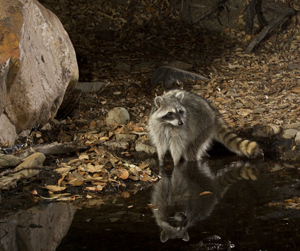
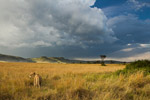

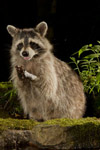
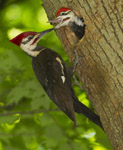


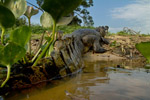
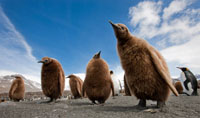
.jpg)

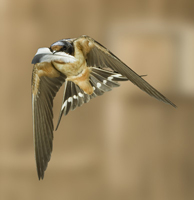
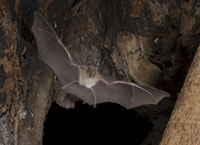
The Ocelot
The Waterhole
Bushbaby
Barn Swallow
King Penguin
The Lion and the Landscape
The Bighorn Sheep
The Raccoon
The Pileated Woodpecker
The Striking Rattlesnake
The Pink Salmon
The Spectacled Caimen
Check out our latest web site,
mcdonaldwildlifephotos.com
where we'll be adding portfolios and eventually building up
a searchable data base for photo buyers. We've just started,
and the selection is limited, but it is still worth a visit!
Office Phone: (717) 543-6423
Or FAX us at: (717) 543-5342
The Story Behind the Photograph
Photographing Bats in Costa Rica

Two Orange Nectar-feeding Bats collide, made with a Range IR.
Recently we returned from our second Photo Tour in Costa Rica, where, quite unexpectedly, I had another opportunity to photograph bats. We were staying in a lodge in northern Costa Rica, photographing toucans, aracaris, and other birds, as well as coatimundis, insects, and snakes. There was a hummingbird feeding station set up in the forest where, I was told, few hummers visited. It was a disappointment, our lodge host said, before adding, but bats are drinking up all of the nectar each night!
Fortunately the feeding station wasn't too deep in the forest, just a hundred yards or so down a very muddy, slippery jungle trail. On our first evening I hiked out after dark to investigate, watching carefully as I walked, not only to not slip and fall but also to avoid stepping upon a Fer-de-Lance, a wickedly venomous snake that roams the jungles at night. Although I'd love to see one of these snakes in the wild, I'd like to do so under my terms.


When I arrived at the feeders bats were swooping about everywhere, appearing as quick splashes of light in my headlamp. I sat down on a bench to watch and, within minutes and amongst the mosquitos, I realized a great shooting situation was at hand. The next afternoon I returned.
As best I could off-site I had previsualized how I wanted to set up the flashes and Range IR camera trigger, but when I hiked back in with the gear I found I still wasn't prepared. I needed more gear, and hiked back to the lodge for the extra accessories. When I set up, I found that our wonderful air security system, TSA, had been through my bags and had turned on one flash, draining the batteries, and removed and then reinserted the batteries the wrong way, frying another flash! So, another trip back to the lodge for replacements.
Although the set-up, afterwards, was reasonably straight forward, it still took nearly three hours to rig up several Manfrotto Lightstands, three Manfrotto Articulating Arms with Super Clamps, and the Range IR and four Flashes. I set up the Range IR at a position 180 degrees opposite what I'd done with the Tanzanian bats just a little over a month earlier, now placing the Range IR so that the beam pointed upwards towards one of the hummingbird feeders.
The beauty of the Range IR is the rheostat-like dial that allowed me to 'put out' a beam far enough to reach the hummingbird feeder but no further, so that the jungle canopy and vegetation overhead didn't trip the trigger. The Range IR's beam can be adjusted to trigger from about 3 feet to around 30, and for this series I had the beam set for about five feet.
 For focusing, I had to prefocus on the spot where I expected the bat to be, which, for the most part, was directly above the Range IR and near the hummingbird feeder. I wired the Range IR to a flash (there is a port in the Range IR to attach either a flash or a camera via an RCA plug) so that as soon as the beam was broken the flash would fire, virtually instantaneously. Had I tried to wire the Range IR to a camera I'd have to account for the camera's abominable lag time, which would have been far too slow for catching a bat. Indeed, a bat would probably have broken the beam, drank at the feeder, and flew off before the camera would have fired. I'm not implying that this procedure is slow, although it is, but that the bats really, really move fast!
For focusing, I had to prefocus on the spot where I expected the bat to be, which, for the most part, was directly above the Range IR and near the hummingbird feeder. I wired the Range IR to a flash (there is a port in the Range IR to attach either a flash or a camera via an RCA plug) so that as soon as the beam was broken the flash would fire, virtually instantaneously. Had I tried to wire the Range IR to a camera I'd have to account for the camera's abominable lag time, which would have been far too slow for catching a bat. Indeed, a bat would probably have broken the beam, drank at the feeder, and flew off before the camera would have fired. I'm not implying that this procedure is slow, although it is, but that the bats really, really move fast!
To trigger my other flashes I made a hard-wired system that was coupled with a Quantum Super Slave unit. Unfortunately, towards the end of my first night's shooting both of my slaves (I always carry two, as one is the back up) ran out of power and I didn't have an extra 9 volt battery replacement. That ended that evening's shoot!
The following day I got several replacements, made some slight changes in the flash set up and camera positioning, and along with almost everyone on our Photo Tour, we made bat shots. Because the Range IR was coupled with the flash, everyone could shoot, as their camera shutters simply needed to be open during an exposure. To accomplish this, we shot on motor-drive, at 3.2 second exposures, and most of the time the camera shutters were open when the flashes fired. Occasionally, inevitably, a shutter would be closed in mid-cycle, but with the 500 plus shots made that evening those misses were inconsequential.
Although carrying Manfrotto lightstands, Articulating Arms and Super Clamps, six Flash units, and two Range IRs (one, back up), as well as the wires and cables, was a bit of a hassle, and a lot of luggage, the effort was worth it. Once again, the Range IR proved invaluable, with its little footprint, barely bigger than a pack of playing cards, making it easy to transport and to set up.
We can't wait to return to Costa Rica for another Photo Tour, and plan on doing so in 2015, if not before. We'll be shooting bats as part of the tour, a truly exciting addition where everyone captures images few have, and that are really unique and exciting.
If you'd like to learn more about this type of photography, there is a remote chance that I may do an Advanced Flash Nature Photo Course this year – if you are interested in this, please contact the office and by the response I’ll decide. In that course I'll be covering TTL and Manual flash, and perhaps more importantly, I'll be demonstrating and teaching techniques with the Range IR and you'll be using this equipment in the projects I'll be assigning you.
The basics of all this flash information will be covered in our Complete Digital Nature Photo Course as well, but not in the depth of the Advanced course. Nonetheless, the CDCNPC would get you started.
The Story Behind the Photograph
Photographing Bats in Costa Rica

Two Orange Nectar-feeding Bats collide, made with a Range IR.
Recently we returned from our second Photo Tour in Costa Rica, where, quite unexpectedly, I had another opportunity to photograph bats. We were staying in a lodge in northern Costa Rica, photographing toucans, aracaris, and other birds, as well as coatimundis, insects, and snakes. There was a hummingbird feeding station set up in the forest where, I was told, few hummers visited. It was a disappointment, our lodge host said, before adding, but bats are drinking up all of the nectar each night!
Fortunately the feeding station wasn't too deep in the forest, just a hundred yards or so down a very muddy, slippery jungle trail. On our first evening I hiked out after dark to investigate, watching carefully as I walked, not only to not slip and fall but also to avoid stepping upon a Fer-de-Lance, a wickedly venomous snake that roams the jungles at night. Although I'd love to see one of these snakes in the wild, I'd like to do so under my terms.


When I arrived at the feeders bats were swooping about everywhere, appearing as quick splashes of light in my headlamp. I sat down on a bench to watch and, within minutes and amongst the mosquitos, I realized a great shooting situation was at hand. The next afternoon I returned.
As best I could off-site I had previsualized how I wanted to set up the flashes and Range IR camera trigger, but when I hiked back in with the gear I found I still wasn't prepared. I needed more gear, and hiked back to the lodge for the extra accessories. When I set up, I found that our wonderful air security system, TSA, had been through my bags and had turned on one flash, draining the batteries, and removed and then reinserted the batteries the wrong way, frying another flash! So, another trip back to the lodge for replacements.
Although the set-up, afterwards, was reasonably straight forward, it still took nearly three hours to rig up several Manfrotto Lightstands, three Manfrotto Articulating Arms with Super Clamps, and the Range IR and four Flashes. I set up the Range IR at a position 180 degrees opposite what I'd done with the Tanzanian bats just a little over a month earlier, now placing the Range IR so that the beam pointed upwards towards one of the hummingbird feeders.
The beauty of the Range IR is the rheostat-like dial that allowed me to 'put out' a beam far enough to reach the hummingbird feeder but no further, so that the jungle canopy and vegetation overhead didn't trip the trigger. The Range IR's beam can be adjusted to trigger from about 3 feet to around 30, and for this series I had the beam set for about five feet.
 For focusing, I had to prefocus on the spot where I expected the bat to be, which, for the most part, was directly above the Range IR and near the hummingbird feeder. I wired the Range IR to a flash (there is a port in the Range IR to attach either a flash or a camera via an RCA plug) so that as soon as the beam was broken the flash would fire, virtually instantaneously. Had I tried to wire the Range IR to a camera I'd have to account for the camera's abominable lag time, which would have been far too slow for catching a bat. Indeed, a bat would probably have broken the beam, drank at the feeder, and flew off before the camera would have fired. I'm not implying that this procedure is slow, although it is, but that the bats really, really move fast!
For focusing, I had to prefocus on the spot where I expected the bat to be, which, for the most part, was directly above the Range IR and near the hummingbird feeder. I wired the Range IR to a flash (there is a port in the Range IR to attach either a flash or a camera via an RCA plug) so that as soon as the beam was broken the flash would fire, virtually instantaneously. Had I tried to wire the Range IR to a camera I'd have to account for the camera's abominable lag time, which would have been far too slow for catching a bat. Indeed, a bat would probably have broken the beam, drank at the feeder, and flew off before the camera would have fired. I'm not implying that this procedure is slow, although it is, but that the bats really, really move fast!
To trigger my other flashes I made a hard-wired system that was coupled with a Quantum Super Slave unit. Unfortunately, towards the end of my first night's shooting both of my slaves (I always carry two, as one is the back up) ran out of power and I didn't have an extra 9 volt battery replacement. That ended that evening's shoot!
The following day I got several replacements, made some slight changes in the flash set up and camera positioning, and along with almost everyone on our Photo Tour, we made bat shots. Because the Range IR was coupled with the flash, everyone could shoot, as their camera shutters simply needed to be open during an exposure. To accomplish this, we shot on motor-drive, at 3.2 second exposures, and most of the time the camera shutters were open when the flashes fired. Occasionally, inevitably, a shutter would be closed in mid-cycle, but with the 500 plus shots made that evening those misses were inconsequential.
Although carrying Manfrotto lightstands, Articulating Arms and Super Clamps, six Flash units, and two Range IRs (one, back up), as well as the wires and cables, was a bit of a hassle, and a lot of luggage, the effort was worth it. Once again, the Range IR proved invaluable, with its little footprint, barely bigger than a pack of playing cards, making it easy to transport and to set up.
We can't wait to return to Costa Rica for another Photo Tour, and plan on doing so in 2015, if not before. We'll be shooting bats as part of the tour, a truly exciting addition where everyone captures images few have, and that are really unique and exciting.
If you'd like to learn more about this type of photography, there is a remote chance that I may do an Advanced Flash Nature Photo Course this year – if you are interested in this, please contact the office and by the response I’ll decide. In that course I'll be covering TTL and Manual flash, and perhaps more importantly, I'll be demonstrating and teaching techniques with the Range IR and you'll be using this equipment in the projects I'll be assigning you.
The basics of all this flash information will be covered in our Complete Digital Nature Photo Course as well, but not in the depth of the Advanced course. Nonetheless, the CDCNPC would get you started.
The Story Behind the Photograph
Photographing Bats in Costa Rica

Two Orange Nectar-feeding Bats collide, made with a Range IR.
Recently we returned from our second Photo Tour in Costa Rica, where, quite unexpectedly, I had another opportunity to photograph bats. We were staying in a lodge in northern Costa Rica, photographing toucans, aracaris, and other birds, as well as coatimundis, insects, and snakes. There was a hummingbird feeding station set up in the forest where, I was told, few hummers visited. It was a disappointment, our lodge host said, before adding, but bats are drinking up all of the nectar each night!
Fortunately the feeding station wasn't too deep in the forest, just a hundred yards or so down a very muddy, slippery jungle trail. On our first evening I hiked out after dark to investigate, watching carefully as I walked, not only to not slip and fall but also to avoid stepping upon a Fer-de-Lance, a wickedly venomous snake that roams the jungles at night. Although I'd love to see one of these snakes in the wild, I'd like to do so under my terms.


When I arrived at the feeders bats were swooping about everywhere, appearing as quick splashes of light in my headlamp. I sat down on a bench to watch and, within minutes and amongst the mosquitos, I realized a great shooting situation was at hand. The next afternoon I returned.
As best I could off-site I had previsualized how I wanted to set up the flashes and Range IR camera trigger, but when I hiked back in with the gear I found I still wasn't prepared. I needed more gear, and hiked back to the lodge for the extra accessories. When I set up, I found that our wonderful air security system, TSA, had been through my bags and had turned on one flash, draining the batteries, and removed and then reinserted the batteries the wrong way, frying another flash! So, another trip back to the lodge for replacements.
Although the set-up, afterwards, was reasonably straight forward, it still took nearly three hours to rig up several Manfrotto Lightstands, three Manfrotto Articulating Arms with Super Clamps, and the Range IR and four Flashes. I set up the Range IR at a position 180 degrees opposite what I'd done with the Tanzanian bats just a little over a month earlier, now placing the Range IR so that the beam pointed upwards towards one of the hummingbird feeders.
The beauty of the Range IR is the rheostat-like dial that allowed me to 'put out' a beam far enough to reach the hummingbird feeder but no further, so that the jungle canopy and vegetation overhead didn't trip the trigger. The Range IR's beam can be adjusted to trigger from about 3 feet to around 30, and for this series I had the beam set for about five feet.
 For focusing, I had to prefocus on the spot where I expected the bat to be, which, for the most part, was directly above the Range IR and near the hummingbird feeder. I wired the Range IR to a flash (there is a port in the Range IR to attach either a flash or a camera via an RCA plug) so that as soon as the beam was broken the flash would fire, virtually instantaneously. Had I tried to wire the Range IR to a camera I'd have to account for the camera's abominable lag time, which would have been far too slow for catching a bat. Indeed, a bat would probably have broken the beam, drank at the feeder, and flew off before the camera would have fired. I'm not implying that this procedure is slow, although it is, but that the bats really, really move fast!
For focusing, I had to prefocus on the spot where I expected the bat to be, which, for the most part, was directly above the Range IR and near the hummingbird feeder. I wired the Range IR to a flash (there is a port in the Range IR to attach either a flash or a camera via an RCA plug) so that as soon as the beam was broken the flash would fire, virtually instantaneously. Had I tried to wire the Range IR to a camera I'd have to account for the camera's abominable lag time, which would have been far too slow for catching a bat. Indeed, a bat would probably have broken the beam, drank at the feeder, and flew off before the camera would have fired. I'm not implying that this procedure is slow, although it is, but that the bats really, really move fast!
To trigger my other flashes I made a hard-wired system that was coupled with a Quantum Super Slave unit. Unfortunately, towards the end of my first night's shooting both of my slaves (I always carry two, as one is the back up) ran out of power and I didn't have an extra 9 volt battery replacement. That ended that evening's shoot!
The following day I got several replacements, made some slight changes in the flash set up and camera positioning, and along with almost everyone on our Photo Tour, we made bat shots. Because the Range IR was coupled with the flash, everyone could shoot, as their camera shutters simply needed to be open during an exposure. To accomplish this, we shot on motor-drive, at 3.2 second exposures, and most of the time the camera shutters were open when the flashes fired. Occasionally, inevitably, a shutter would be closed in mid-cycle, but with the 500 plus shots made that evening those misses were inconsequential.
Although carrying Manfrotto lightstands, Articulating Arms and Super Clamps, six Flash units, and two Range IRs (one, back up), as well as the wires and cables, was a bit of a hassle, and a lot of luggage, the effort was worth it. Once again, the Range IR proved invaluable, with its little footprint, barely bigger than a pack of playing cards, making it easy to transport and to set up.
We can't wait to return to Costa Rica for another Photo Tour, and plan on doing so in 2015, if not before. We'll be shooting bats as part of the tour, a truly exciting addition where everyone captures images few have, and that are really unique and exciting.
If you'd like to learn more about this type of photography, there is a remote chance that I may do an Advanced Flash Nature Photo Course this year – if you are interested in this, please contact the office and by the response I’ll decide. In that course I'll be covering TTL and Manual flash, and perhaps more importantly, I'll be demonstrating and teaching techniques with the Range IR and you'll be using this equipment in the projects I'll be assigning you.
The basics of all this flash information will be covered in our Complete Digital Nature Photo Course as well, but not in the depth of the Advanced course. Nonetheless, the CDCNPC would get you started.
The Story Behind the Photograph
Photographing Bats in Costa Rica

Two Orange Nectar-feeding Bats collide, made with a Range IR.
Recently we returned from our second Photo Tour in Costa Rica, where, quite unexpectedly, I had another opportunity to photograph bats. We were staying in a lodge in northern Costa Rica, photographing toucans, aracaris, and other birds, as well as coatimundis, insects, and snakes. There was a hummingbird feeding station set up in the forest where, I was told, few hummers visited. It was a disappointment, our lodge host said, before adding, but bats are drinking up all of the nectar each night!
Fortunately the feeding station wasn't too deep in the forest, just a hundred yards or so down a very muddy, slippery jungle trail. On our first evening I hiked out after dark to investigate, watching carefully as I walked, not only to not slip and fall but also to avoid stepping upon a Fer-de-Lance, a wickedly venomous snake that roams the jungles at night. Although I'd love to see one of these snakes in the wild, I'd like to do so under my terms.


When I arrived at the feeders bats were swooping about everywhere, appearing as quick splashes of light in my headlamp. I sat down on a bench to watch and, within minutes and amongst the mosquitos, I realized a great shooting situation was at hand. The next afternoon I returned.
As best I could off-site I had previsualized how I wanted to set up the flashes and Range IR camera trigger, but when I hiked back in with the gear I found I still wasn't prepared. I needed more gear, and hiked back to the lodge for the extra accessories. When I set up, I found that our wonderful air security system, TSA, had been through my bags and had turned on one flash, draining the batteries, and removed and then reinserted the batteries the wrong way, frying another flash! So, another trip back to the lodge for replacements.
Although the set-up, afterwards, was reasonably straight forward, it still took nearly three hours to rig up several Manfrotto Lightstands, three Manfrotto Articulating Arms with Super Clamps, and the Range IR and four Flashes. I set up the Range IR at a position 180 degrees opposite what I'd done with the Tanzanian bats just a little over a month earlier, now placing the Range IR so that the beam pointed upwards towards one of the hummingbird feeders.
The beauty of the Range IR is the rheostat-like dial that allowed me to 'put out' a beam far enough to reach the hummingbird feeder but no further, so that the jungle canopy and vegetation overhead didn't trip the trigger. The Range IR's beam can be adjusted to trigger from about 3 feet to around 30, and for this series I had the beam set for about five feet.
 For focusing, I had to prefocus on the spot where I expected the bat to be, which, for the most part, was directly above the Range IR and near the hummingbird feeder. I wired the Range IR to a flash (there is a port in the Range IR to attach either a flash or a camera via an RCA plug) so that as soon as the beam was broken the flash would fire, virtually instantaneously. Had I tried to wire the Range IR to a camera I'd have to account for the camera's abominable lag time, which would have been far too slow for catching a bat. Indeed, a bat would probably have broken the beam, drank at the feeder, and flew off before the camera would have fired. I'm not implying that this procedure is slow, although it is, but that the bats really, really move fast!
For focusing, I had to prefocus on the spot where I expected the bat to be, which, for the most part, was directly above the Range IR and near the hummingbird feeder. I wired the Range IR to a flash (there is a port in the Range IR to attach either a flash or a camera via an RCA plug) so that as soon as the beam was broken the flash would fire, virtually instantaneously. Had I tried to wire the Range IR to a camera I'd have to account for the camera's abominable lag time, which would have been far too slow for catching a bat. Indeed, a bat would probably have broken the beam, drank at the feeder, and flew off before the camera would have fired. I'm not implying that this procedure is slow, although it is, but that the bats really, really move fast!
To trigger my other flashes I made a hard-wired system that was coupled with a Quantum Super Slave unit. Unfortunately, towards the end of my first night's shooting both of my slaves (I always carry two, as one is the back up) ran out of power and I didn't have an extra 9 volt battery replacement. That ended that evening's shoot!
The following day I got several replacements, made some slight changes in the flash set up and camera positioning, and along with almost everyone on our Photo Tour, we made bat shots. Because the Range IR was coupled with the flash, everyone could shoot, as their camera shutters simply needed to be open during an exposure. To accomplish this, we shot on motor-drive, at 3.2 second exposures, and most of the time the camera shutters were open when the flashes fired. Occasionally, inevitably, a shutter would be closed in mid-cycle, but with the 500 plus shots made that evening those misses were inconsequential.
Although carrying Manfrotto lightstands, Articulating Arms and Super Clamps, six Flash units, and two Range IRs (one, back up), as well as the wires and cables, was a bit of a hassle, and a lot of luggage, the effort was worth it. Once again, the Range IR proved invaluable, with its little footprint, barely bigger than a pack of playing cards, making it easy to transport and to set up.
We can't wait to return to Costa Rica for another Photo Tour, and plan on doing so in 2015, if not before. We'll be shooting bats as part of the tour, a truly exciting addition where everyone captures images few have, and that are really unique and exciting.
If you'd like to learn more about this type of photography, there is a remote chance that I may do an Advanced Flash Nature Photo Course this year – if you are interested in this, please contact the office and by the response I’ll decide. In that course I'll be covering TTL and Manual flash, and perhaps more importantly, I'll be demonstrating and teaching techniques with the Range IR and you'll be using this equipment in the projects I'll be assigning you.
The basics of all this flash information will be covered in our Complete Digital Nature Photo Course as well, but not in the depth of the Advanced course. Nonetheless, the CDCNPC would get you started.
The Story Behind the Photograph
Photographing Bats in Costa Rica

Two Orange Nectar-feeding Bats collide, made with a Range IR.
Recently we returned from our second Photo Tour in Costa Rica, where, quite unexpectedly, I had another opportunity to photograph bats. We were staying in a lodge in northern Costa Rica, photographing toucans, aracaris, and other birds, as well as coatimundis, insects, and snakes. There was a hummingbird feeding station set up in the forest where, I was told, few hummers visited. It was a disappointment, our lodge host said, before adding, but bats are drinking up all of the nectar each night!
Fortunately the feeding station wasn't too deep in the forest, just a hundred yards or so down a very muddy, slippery jungle trail. On our first evening I hiked out after dark to investigate, watching carefully as I walked, not only to not slip and fall but also to avoid stepping upon a Fer-de-Lance, a wickedly venomous snake that roams the jungles at night. Although I'd love to see one of these snakes in the wild, I'd like to do so under my terms.


When I arrived at the feeders bats were swooping about everywhere, appearing as quick splashes of light in my headlamp. I sat down on a bench to watch and, within minutes and amongst the mosquitos, I realized a great shooting situation was at hand. The next afternoon I returned.
As best I could off-site I had previsualized how I wanted to set up the flashes and Range IR camera trigger, but when I hiked back in with the gear I found I still wasn't prepared. I needed more gear, and hiked back to the lodge for the extra accessories. When I set up, I found that our wonderful air security system, TSA, had been through my bags and had turned on one flash, draining the batteries, and removed and then reinserted the batteries the wrong way, frying another flash! So, another trip back to the lodge for replacements.
Although the set-up, afterwards, was reasonably straight forward, it still took nearly three hours to rig up several Manfrotto Lightstands, three Manfrotto Articulating Arms with Super Clamps, and the Range IR and four Flashes. I set up the Range IR at a position 180 degrees opposite what I'd done with the Tanzanian bats just a little over a month earlier, now placing the Range IR so that the beam pointed upwards towards one of the hummingbird feeders.
The beauty of the Range IR is the rheostat-like dial that allowed me to 'put out' a beam far enough to reach the hummingbird feeder but no further, so that the jungle canopy and vegetation overhead didn't trip the trigger. The Range IR's beam can be adjusted to trigger from about 3 feet to around 30, and for this series I had the beam set for about five feet.
 For focusing, I had to prefocus on the spot where I expected the bat to be, which, for the most part, was directly above the Range IR and near the hummingbird feeder. I wired the Range IR to a flash (there is a port in the Range IR to attach either a flash or a camera via an RCA plug) so that as soon as the beam was broken the flash would fire, virtually instantaneously. Had I tried to wire the Range IR to a camera I'd have to account for the camera's abominable lag time, which would have been far too slow for catching a bat. Indeed, a bat would probably have broken the beam, drank at the feeder, and flew off before the camera would have fired. I'm not implying that this procedure is slow, although it is, but that the bats really, really move fast!
For focusing, I had to prefocus on the spot where I expected the bat to be, which, for the most part, was directly above the Range IR and near the hummingbird feeder. I wired the Range IR to a flash (there is a port in the Range IR to attach either a flash or a camera via an RCA plug) so that as soon as the beam was broken the flash would fire, virtually instantaneously. Had I tried to wire the Range IR to a camera I'd have to account for the camera's abominable lag time, which would have been far too slow for catching a bat. Indeed, a bat would probably have broken the beam, drank at the feeder, and flew off before the camera would have fired. I'm not implying that this procedure is slow, although it is, but that the bats really, really move fast!
To trigger my other flashes I made a hard-wired system that was coupled with a Quantum Super Slave unit. Unfortunately, towards the end of my first night's shooting both of my slaves (I always carry two, as one is the back up) ran out of power and I didn't have an extra 9 volt battery replacement. That ended that evening's shoot!
The following day I got several replacements, made some slight changes in the flash set up and camera positioning, and along with almost everyone on our Photo Tour, we made bat shots. Because the Range IR was coupled with the flash, everyone could shoot, as their camera shutters simply needed to be open during an exposure. To accomplish this, we shot on motor-drive, at 3.2 second exposures, and most of the time the camera shutters were open when the flashes fired. Occasionally, inevitably, a shutter would be closed in mid-cycle, but with the 500 plus shots made that evening those misses were inconsequential.
Although carrying Manfrotto lightstands, Articulating Arms and Super Clamps, six Flash units, and two Range IRs (one, back up), as well as the wires and cables, was a bit of a hassle, and a lot of luggage, the effort was worth it. Once again, the Range IR proved invaluable, with its little footprint, barely bigger than a pack of playing cards, making it easy to transport and to set up.
We can't wait to return to Costa Rica for another Photo Tour, and plan on doing so in 2015, if not before. We'll be shooting bats as part of the tour, a truly exciting addition where everyone captures images few have, and that are really unique and exciting.
If you'd like to learn more about this type of photography, there is a remote chance that I may do an Advanced Flash Nature Photo Course this year – if you are interested in this, please contact the office and by the response I’ll decide. In that course I'll be covering TTL and Manual flash, and perhaps more importantly, I'll be demonstrating and teaching techniques with the Range IR and you'll be using this equipment in the projects I'll be assigning you.
The basics of all this flash information will be covered in our Complete Digital Nature Photo Course as well, but not in the depth of the Advanced course. Nonetheless, the CDCNPC would get you started.
The Story Behind the Photograph
Photographing Bats in Costa Rica

Two Orange Nectar-feeding Bats collide, made with a Range IR.
Recently we returned from our second Photo Tour in Costa Rica, where, quite unexpectedly, I had another opportunity to photograph bats. We were staying in a lodge in northern Costa Rica, photographing toucans, aracaris, and other birds, as well as coatimundis, insects, and snakes. There was a hummingbird feeding station set up in the forest where, I was told, few hummers visited. It was a disappointment, our lodge host said, before adding, but bats are drinking up all of the nectar each night!
Fortunately the feeding station wasn't too deep in the forest, just a hundred yards or so down a very muddy, slippery jungle trail. On our first evening I hiked out after dark to investigate, watching carefully as I walked, not only to not slip and fall but also to avoid stepping upon a Fer-de-Lance, a wickedly venomous snake that roams the jungles at night. Although I'd love to see one of these snakes in the wild, I'd like to do so under my terms.


When I arrived at the feeders bats were swooping about everywhere, appearing as quick splashes of light in my headlamp. I sat down on a bench to watch and, within minutes and amongst the mosquitos, I realized a great shooting situation was at hand. The next afternoon I returned.
As best I could off-site I had previsualized how I wanted to set up the flashes and Range IR camera trigger, but when I hiked back in with the gear I found I still wasn't prepared. I needed more gear, and hiked back to the lodge for the extra accessories. When I set up, I found that our wonderful air security system, TSA, had been through my bags and had turned on one flash, draining the batteries, and removed and then reinserted the batteries the wrong way, frying another flash! So, another trip back to the lodge for replacements.
Although the set-up, afterwards, was reasonably straight forward, it still took nearly three hours to rig up several Manfrotto Lightstands, three Manfrotto Articulating Arms with Super Clamps, and the Range IR and four Flashes. I set up the Range IR at a position 180 degrees opposite what I'd done with the Tanzanian bats just a little over a month earlier, now placing the Range IR so that the beam pointed upwards towards one of the hummingbird feeders.
The beauty of the Range IR is the rheostat-like dial that allowed me to 'put out' a beam far enough to reach the hummingbird feeder but no further, so that the jungle canopy and vegetation overhead didn't trip the trigger. The Range IR's beam can be adjusted to trigger from about 3 feet to around 30, and for this series I had the beam set for about five feet.
 For focusing, I had to prefocus on the spot where I expected the bat to be, which, for the most part, was directly above the Range IR and near the hummingbird feeder. I wired the Range IR to a flash (there is a port in the Range IR to attach either a flash or a camera via an RCA plug) so that as soon as the beam was broken the flash would fire, virtually instantaneously. Had I tried to wire the Range IR to a camera I'd have to account for the camera's abominable lag time, which would have been far too slow for catching a bat. Indeed, a bat would probably have broken the beam, drank at the feeder, and flew off before the camera would have fired. I'm not implying that this procedure is slow, although it is, but that the bats really, really move fast!
For focusing, I had to prefocus on the spot where I expected the bat to be, which, for the most part, was directly above the Range IR and near the hummingbird feeder. I wired the Range IR to a flash (there is a port in the Range IR to attach either a flash or a camera via an RCA plug) so that as soon as the beam was broken the flash would fire, virtually instantaneously. Had I tried to wire the Range IR to a camera I'd have to account for the camera's abominable lag time, which would have been far too slow for catching a bat. Indeed, a bat would probably have broken the beam, drank at the feeder, and flew off before the camera would have fired. I'm not implying that this procedure is slow, although it is, but that the bats really, really move fast!
To trigger my other flashes I made a hard-wired system that was coupled with a Quantum Super Slave unit. Unfortunately, towards the end of my first night's shooting both of my slaves (I always carry two, as one is the back up) ran out of power and I didn't have an extra 9 volt battery replacement. That ended that evening's shoot!
The following day I got several replacements, made some slight changes in the flash set up and camera positioning, and along with almost everyone on our Photo Tour, we made bat shots. Because the Range IR was coupled with the flash, everyone could shoot, as their camera shutters simply needed to be open during an exposure. To accomplish this, we shot on motor-drive, at 3.2 second exposures, and most of the time the camera shutters were open when the flashes fired. Occasionally, inevitably, a shutter would be closed in mid-cycle, but with the 500 plus shots made that evening those misses were inconsequential.
Although carrying Manfrotto lightstands, Articulating Arms and Super Clamps, six Flash units, and two Range IRs (one, back up), as well as the wires and cables, was a bit of a hassle, and a lot of luggage, the effort was worth it. Once again, the Range IR proved invaluable, with its little footprint, barely bigger than a pack of playing cards, making it easy to transport and to set up.
We can't wait to return to Costa Rica for another Photo Tour, and plan on doing so in 2015, if not before. We'll be shooting bats as part of the tour, a truly exciting addition where everyone captures images few have, and that are really unique and exciting.
If you'd like to learn more about this type of photography, there is a remote chance that I may do an Advanced Flash Nature Photo Course this year – if you are interested in this, please contact the office and by the response I’ll decide. In that course I'll be covering TTL and Manual flash, and perhaps more importantly, I'll be demonstrating and teaching techniques with the Range IR and you'll be using this equipment in the projects I'll be assigning you.
The basics of all this flash information will be covered in our Complete Digital Nature Photo Course as well, but not in the depth of the Advanced course. Nonetheless, the CDCNPC would get you started.
Past Stories Behind the Photograph









.jpg)



The Ocelot
The Waterhole
Bushbaby
Barn Swallow
King Penguin
The Lion and the Landscape
The Bighorn Sheep
The Raccoon
The Pileated Woodpecker
The Striking Rattlesnake
The Pink Salmon
The Spectacled Caimen
Check out our latest web site,
mcdonaldwildlifephotos.com
where we'll be adding portfolios and eventually building up
a searchable data base for photo buyers. We've just started,
and the selection is limited, but it is still worth a visit!
Past Stories Behind the Photograph









.jpg)



The Ocelot
The Waterhole
Bushbaby
Barn Swallow
King Penguin
The Lion and the Landscape
The Bighorn Sheep
The Raccoon
The Pileated Woodpecker
The Striking Rattlesnake
The Pink Salmon
The Spectacled Caimen
Check out our latest web site,
mcdonaldwildlifephotos.com
where we'll be adding portfolios and eventually building up
a searchable data base for photo buyers. We've just started,
and the selection is limited, but it is still worth a visit!
Office Phone: (717) 543-6423
Or FAX us at: (717) 543-5342


